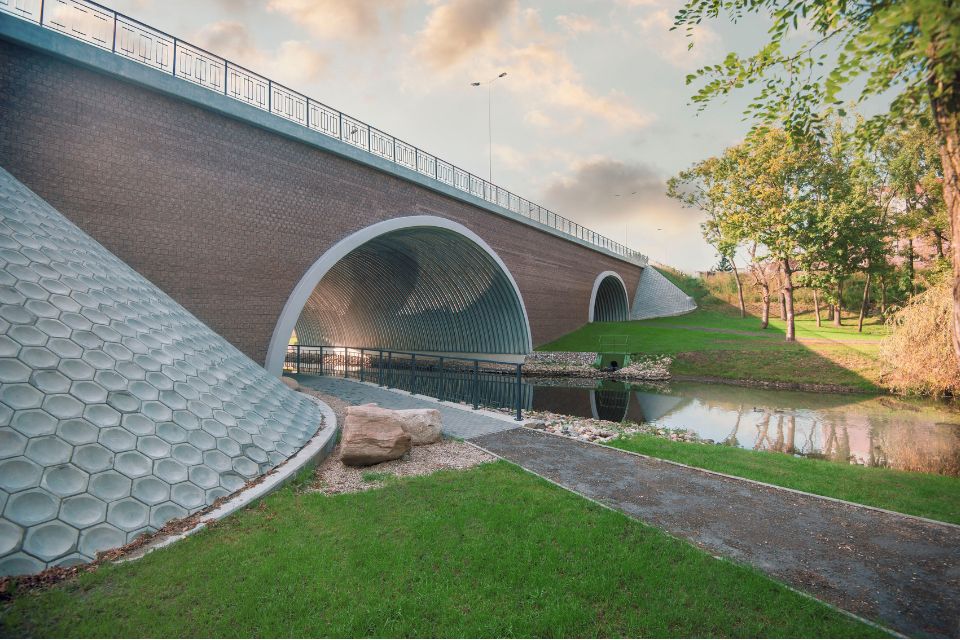What is the EU Taxonomy?
…and what is the EU Taxonomy’s impact on infrastructure construction in civil engineering?
The EU Taxonomy is a comprehensive classification system that classifies and defines what can be called “sustainable activities”. The framework’s primary objective is to guide and harmonize investments to support the European Union’s transition toward a climate-neutral, circular, and sustainable economy by clarifying definitions and measurements for environmentally sustainable economic activities.
As part of the broader European Green Deal, the Taxonomy is a regulatory framework to promote green investments and eliminate misleading claims, i.e., greenwashing. The taxonomy defines criteria for claiming that economic activities align with a net zero trajectory by 2050. The framework came about as an instrument for financial markets but has expanded to include multiple industries, including civil engineering and infrastructure construction.
EU Taxonomy and civil infrastructure engineering
The EU Taxonomy framework poses multiple challenges and has significant implications for civil engineering. Forming the foundations on which societies function, and likewise being heavily resource intensive, infrastructure – including bridges and culverts, water management systems and geotechnical solutions – is critical to how successful circular economy initiatives are. And changes to how civil engineering projects are financed, planned, designed and executed are inevitable in ensuring alignment with the EU Taxonomy and to successfully evolving to become verifiably durable, resilient and sustainable.
The EU Taxonomy sets clear benchmarks for infrastructure projects to ensure that they align with and are planned from the outset to meet sustainability goals, including climate resilience, environmental protection, and resource efficiency.
What does the EU Taxonomy cover?
The EU Taxonomy is structured around six environmental objectives:
- Climate change mitigation: Reducing greenhouse gas (GHG) emissions, a key priority for the EU.
- Climate change adaptation: Ensuring projects and assets can withstand the impacts of climate change.
- Sustainable use and protection of water and marine resources: Efficiently managing water resources and protecting aquatic ecosystems.
- Transition to a circular economy: Encouraging resource efficiency, recycling, and minimizing waste.
- Pollution prevention and control: Reducing air, water, and soil pollution.
- Protection and restoration of biodiversity and ecosystems: Maintaining and improving ecosystems, including in construction activities.
For an economic activity to be classified as sustainable under the Taxonomy, it must contribute substantially to at least one of these objectives while not significantly harming any of the others, a concept known as the Do No Significant Harm (DNSH) principle. Companies must also ensure that activities adhere to minimum social safeguards, which include labor rights and human rights frameworks and standards.
Implications for civil engineering and infrastructure construction
The EU Taxonomy affects all aspects of civil engineering, from project design to material selection and specifications, as well as long-term operation and maintenance. In the infrastructure construction sector, where building bridges and culverts, stormwater management systems, and implementing geotechnical solutions as standalone or as parts of bigger civil engineering initiatives, these guidelines drive infrastructure development toward environmental soundness and resilience in the face of climate change.
1. Bridges and culverts
Bridges and culverts are vital components of transportation networks and water systems. Under the EU Taxonomy, several key principles affect the design and construction of these structures.
First, in the face of a changing climate and increased precipitation, flooding and other extreme weather, bridges and culverts will need to withstand what were once aberrant weather patterns. These weather conditions can contribute to, for example, the need to consider everything from the need for appropriate drainage systems to mitigate surface water pollution to accelerated soil erosion to frequent flooding and demands for higher bridge clearances.
Bridges and culverts must be designed to minimize energy consumption and GHG emissions during construction and operation. Material selection, such as circular, recyclable and long-lasting materials, such as steel, is one part of the equation. Another part is accounting for long-term maintenance, the efficient and sustainable transportation and logistics involved in the construction process, and the use of renewable energy sources during construction and repair.
Understanding the costs of the full life cycle and planning for integration within the environment for less disruption and support for biodiversity (such as wildlife corridors and fish-friendly culvert designs) will be critical to creating infrastructure that is Taxonomy compliant and sustainable.
2. Water management systems
Water management systems are essential for the supply of potable water, waste water treatment, and flood control. They also play a crucial role in managing the impacts of climate change, such as increased rainfall and flooding. The EU Taxonomy shapes the planning and operation of these systems in several ways.
The core of sustainable water use is safeguarding water resources and protecting people and infrastructure from the damage that flooding (or drought) can do. Climate resilience depends on adequate flood control and mitigation efforts. As climate change intensifies, the frequency and severity of floods increases, and stormwater management systems must be designed with adaptive features.
While there are many different methods for managing an overabundance of water, tanks for stormwater retention, attenuation, fire tank systems and rainwater harvesting contribute to circular economy principles, enabling the recycling of rain water for other uses – each of which aligns with the EU Taxonomy.
3. Geotechnical solutions
Geotechnical engineering plays a crucial role in the foundation and structural integrity of infrastructure projects. Geotechnical solutions fulfill the EU Taxonomy focus on durable and environmentally responsible infrastructure support.
Geotechnical solutions enable mitigation for climate-change-related challenges like soil erosion, landslide risk, and subsidence. Material-efficient geotechnical products and engineering make soil stabilization and erosion control as well as groundwater protection possible, aligning with EU Taxonomy stipulations that construction activities must avoid contamination of groundwater sources and form the foundation for sustainable and long-lasting stability.
EU Taxonomy: Economic and social impacts
The EU Taxonomy’s influence extends beyond environmental considerations to economic and social domains. Sustainable infrastructure is expected to enhance long-term resilience and reduce operational costs by minimizing environmental risks, such as damage from floods or subsidence. Although initial capital costs might be higher due to the requirement for sustainable materials and design innovation, the long-term benefits—such as reduced maintenance costs, lower energy consumption, and enhanced public safety—offer substantial economic advantages.
EU Taxonomy-compliant projects stand a better chance of securing funding from investors focused on environmental, social, and governance (ESG) criteria. As financial markets increasingly align with sustainability objectives, construction companies and civil engineering firms adhering to Taxonomy standards may find it easier to attract green finance, grants, and loans.
In terms of social impact, sustainable infrastructure provides broader societal benefits by enhancing quality of life. For example, cleaner water systems, flood protection, and well-maintained transportation networks are essential for public health, safety, and economic productivity.
A framework for resilience
The EU Taxonomy framework profoundly impacts infrastructure construction in civil engineering with clear requirements for meeting guidelines for sustainability and resilience. The EU Taxonomy encodes a few ways to build resilience into infrastructure projects to contribute to climate mitigation and adaptation, biodiversity protection, pollution control, and circular economy practices. While posing challenges, such as the need for innovative designs and higher upfront costs, the long-term benefits of the EU Taxonomy are undeniable, both in terms of environmental protection and financial sustainability.
Find out more about ViaCon’s sustainability work or get in touch to learn how ViaCon can help you achieve your sustainability goals.

